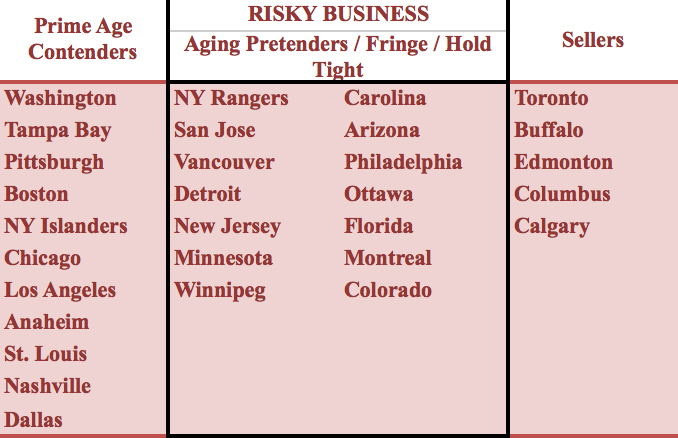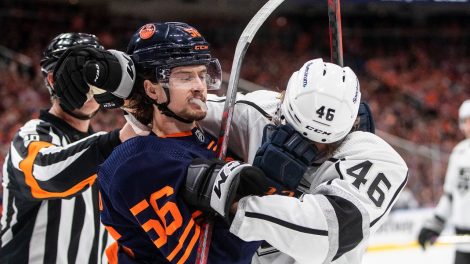After a largely stagnant season in terms of trade activity, the number of deals has rapidly been picking as we approach trade deadline day on February 29th. The sellers are looking to shed players for prospects or draft picks, while the buyers are often willing to sell off parts of their future for a chance to win now.
So when is it wise for a team to go for it at the cost of the future, and when should they be more mindful of the years to come?
Last year around this time, we looked at the value of an NHL draft pick. What that study ignored was the time value of these picks. A pick in an upcoming draft has a fairly fixed relative worth compared to other picks in any given draft, but the players selected will take time to develop and contribute at the NHL level.
So let’s look at the time value of these picks. Within each draft pick range, we need to see how long it takes 50 per cent of those players to be a consistent NHL contributor (marked as 150 GP). Looking at this graph, the value varies considerably.

*GAR tabulated by War-On-Ice.com
Consider that contenders trading away picks will be picking in the 11-30 range of the first round, and late in other rounds. Looking at the chart, we can see there is a greater than 50 per cent probability that any successful picks made with those first-rounders will take five or more years to contribute regularly in the NHL. For a team in win-now mode, it makes sense to trade a lottery ticket that will take five years to pay off for a skater who can contribute right away.
By adding Andrew Ladd this week, the Blackhawks looked to replenish some of the scoring they lost after last year’s Cup run when Kris Versteeg and Brandon Saad departed. They’re trying to keep their window open as wide as possible for as long as possible, so when you consider the plausible five-year wait time before their first-rounder pays off, Ladd has significantly more value to the Blackhawks.
The other side of this is, how much do those rentals actually contribute? If you can add a player who fills the role of a 0.4 point-per-game scorer, it makes sense to trade away a mid-to-late round draft pick because of the present vs. future value exchange.
The problem is you’re not simply adding 0.4 points per game. This player is likely replacing another on the roster, who will get pushed to a lesser role. So the real value is found in how much they improve upon the player who they pushed down the depth chart. Again with Chicago, having Ladd push Andrew Shaw down into a bottom-six role helps the Hawks find a more balanced lineup, similar to what they had last season.
Things become questionable when a team like the San Jose Sharks trade multiple second-round picks for depth players such as Roman Polak and Nick Spaling. The combined worth of the picks they dealt are approximately on par with a mid-first round pick. Neither Polak nor Spaling adds enough to seemingly make this worth it.
With the careers of Joe Thornton and Patrick Marleau winding down, the Sharks are making a last gasp before that era passes by. But adding two depth players for a few months of marginal performance in exchange for two chances to add future contributors seems like a poor exchange. If your window is about to close, it seems like a waste to give up on any chances to restock the cupboard. It may be better to roll the dice with what you have.
Now we’re going to break the NHL up into three groups: Legitimate contenders, the mushy middle and the sellers.
For the contenders, it makes perfect sense to sacrifice picks and prospects for immediate benefit. Mushy middle teams are pretenders who seem likely to push to win now, even if it causes long-term pain, and fringe teams who are looking to make a move to get into the playoffs even though their window is still a few years away. And, obviously, the sellers are at least four or five years away from contending for anything.
Note that these groups are not based on NHL standings, but rather roster makeup and the age of key contributors.
THE LESSON
It’s easy to forget, but developing players from the draft takes a significant amount of time – often three-to-five years. Therefore, it makes perfect sense for teams with legitimate Stanley Cup aspirations to exchange picks for key pieces to a Cup run. But if those pieces have limited value, the logic breaks down a fair bit.
Teams on the fringe of contention or whose window is rapidly closing have far more to lose by adding edges to their roster for futures that could help long-term competitiveness.
It’s those teams that are most interesting to watch around the trade deadline. They could either make moves that aid them in the future, or make substantial mistakes that keep their head just above water for now, but hamper them down the line.










